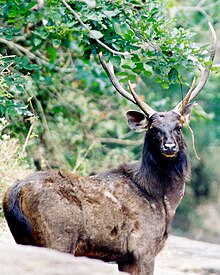Sambar Deer
| Sambar | |
|---|---|
 |
|
| Scientific classification | |
| Kingdom: | Animalia |
| Phylum: | Chordata |
| Class: | Mammalia |
| Order: | Artiodactyla |
| Family: | Cervidae |
| Subfamily: | Cervinae |
| Genus: | Rusa |
| Species: | R. unicolor |
| Binomial name | |
|
Rusa unicolor (Kerr, 1792) |
|
 |
|
| Range of the sambar deer | |
| Synonyms | |
|
|
The sambar (Rusa unicolor) is a large deer native to the Indian subcontinent, southern China and Southeast Asia. Although it primarily refers to R. unicolor, the name "sambar" is also sometimes used to refer to the Philippine deer (called the "Philippine sambar") and the Javan rusa (called the "Sunda sambar"). The name is also spelled sambur or sambhur.
The appearance and the size of sambar vary widely across their range, which has led to considerable taxonomic confusion in the past; over forty different scientific synonyms have been used for the species. In general, they attain a height of 102 to 160 centimetres (40 to 63 in) at the shoulder and may weigh as much as 546 kg (1,204 lb), though more typically 100 to 350 kg (220 to 770 lb). Head and body length varies from 1.62 to 2.7 m (5.3 to 8.9 ft), with a 22 to 35 cm (8.7 to 13.8 in) tail. Individuals belonging to western subspecies tend to be larger than those from the east and females are smaller than males. Among all living cervid species, only the moose and the elk can attain larger sizes.
The large, rugged antlers are typically rusine, the brow tines being simple and the beams forked at the tip, so that they have only three tines. The antlers are typically up to 110 cm (43 in) long in fully adult individuals. As with most deer, only the males have antlers.
The shaggy coat can be anything from yellowish brown to dark grey in colour and, while it is usually uniform in colour, some subspecies have chestnut marks on the rump and underparts. Sambar also have a small but dense mane, which tends to be more prominent in males. The tail is relatively long for deer, and is generally black above with a whitish underside.
Adult males and pregnant or lactating females possess an unusual hairless, blood-red spot located about halfway down the underside of their throats. This sometimes oozes a white liquid, and is apparently glandular in nature.
The sambar is distributed in much of southern Asia as far north as the south-facing slopes of the Himalayas, mainland Southeast Asia including Burma, Thailand, Indochina, the Malay Peninsula, South China including Hainan Island, Taiwan, and the Indonesian islands of Sumatra and Borneo. In the Himalayan foothills, Myanmar and eastern Taiwan it ranges up to 3,500 m (11,500 ft). It inhabits tropical dry forests, tropical seasonal forests, subtropical mixed forests with stands of conifers, broadleaved deciduous and broadleaved evergreen trees, to tropical rainforests, and seldom moves far from water sources.
...
Wikipedia

